The Man with the White Handkerchief – Caroline Broch
The personal memories of a survivor of the tragedy at Oradour in June 1944 – a lesson in history.
Although I have spent most of my life in Paris, my family lived in a small town called Saint Junien in the Haute-Vienne region of central France, about 20 mls (32km) from the city of Limoges. Saint Junien is just 8 miles (13 kms) from the village of Oradour sur Glane where in June 1944 the NAZI’s murdered the entire inhabitants of 642 men, women & children.
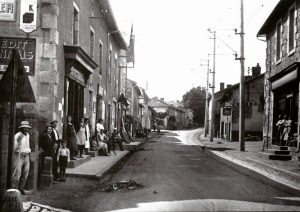
The charming village of Oradour sur Glane, Haute Vienne, France – c.1935
As a teenager my love of sculpture, regularly led me to visit our own town’s famous 12th century collegiate Church of Saint Junien to see the beautiful polychrome sculptures within. As a shy young girl, I would usually stay at the back during the services, so that I could “escape” early after the service, and it was on one of these visits that I first began to notice a gentleman who also stood at the rear of the church. He seemed terribly sad and always held an immaculate white handkerchief in his hand and had tears in his eyes.

Robert Besson – c1980
I was too shy to talk to him as we left each time, and only exchanged customary smiles but, some time later, I eventually asked another person who he was. “Mademoiselle, don’t you know?” she replied, “It is Monsieur Besson, survivor of Oradour. His family were murdered there”.
A few years later I eventually made his acquaintance in his clothes shop in Saint Junien town centre. He was a friendly and modest person although I could detect that he was also a little shy, perhaps a little withdrawn.
He met my father, who had been in the RAF during the war as a navigator on Halifax bombers with the French heavy bomber squadrons based in England, and they seemed to immediately click in a way that people do when having mutually experienced traumatic events like the horrors of war. One Sunday in the summer we invited neighbours round to the house and we also invited Monsieur Besson, who duly arrived.
It was the opportunity I was waiting for. I was always aware of the generally accepted story about Oradour but had never met anyone who had experienced it at first hand. For a young person who had never experienced war it was a fascination to understand how people coped with such things. Although I was very mindful not to cause any more distress to him, I was surprised that he immediately opened up to me and told me his story.
Robert L.M. Besson in the 1940’s
Robert was born in 1917 and lived, with his elder brother Abel and their parents Guillaume and Léonie, who ran the drapery shop at Oradour sur Glane.
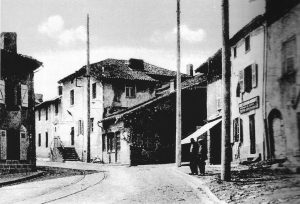
Besson’s drapery shop, (right side, with the awning, on the corner behind the two men standing) Oradour sur Glane c.1930
Robert had been called up for military service in 1935 and was mobilised when war broke out in 1939, but returned home following France’s Armistice with Germany in June 1940 when hostilities ended. Robert’s brother Abel had been captured whilst fighting with the French Army and was made a Prisoner of War.

Oradour football team 1943 – Robert Besson 4th from left on the top row
From July 1940, France’s Third Republic was virtually no longer in existence and was divided almost in half between the German occupied north and west of France and the euphemistically named “unoccupied” or “Free Zone” to the south and east, administered by a pseudo independent French government at Vichy under Maréchal Pétain – hero of the First World War. Despite the Vichy regime continuing to become more collaborationist with the Germans, they attempted to resist demands for the compulsory supply of more and more young Frenchmen to work in Germany, until the relationship changed completely in November 1942 when the Germans took control of the whole of France following the Allied Landings in French North Africa.
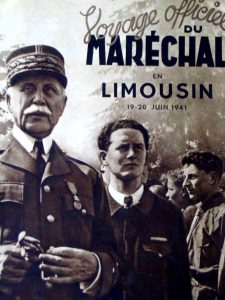
Along with most men of his age in the Unoccupied Zone, Robert had been “summoned” for compulsory labour service in Germany and like many, he refused. In fact he was summoned seven times altogether which he ignored, but now the Germans were in charge and by the time that the SS arrived in Oradour on that fateful morning, Robert’s first thoughts were that they had come for him.
“ On 10th June 1944 I was in the shop. It was about 2 p.m. I opened the door and immediately saw a German SS vehicle with a machine gun. As it went past, it stopped and picked up a person I knew well, the local butcher. Very quickly, I went to a neighbour’s house, who was hiding her own nephew: a friend of mine called Jacques Garraud.
But the SS had not just come for Robert, they had arrived for a much more sinister reason.
D-Day
4 days earlier on 6th June the Allies landed in Normandy and large numbers of German troops were now urgently rushing North, severely reducing the numbers of German troops left to control the rest of France. Meanwhile, resistance groups, with support from British and US agents and special forces, were doing their utmost to prevent German reinforcements moving towards Normandy by blowing up railway and road routes across France.
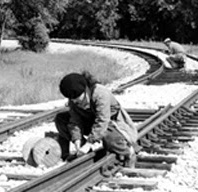

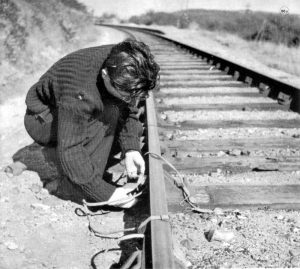
Prevention of reinforcements reaching Normandy were vital to the success of the Allied Landings
As news of the landings spread, the mood of both the French and their German occupiers changed immediately. With the supressed emotions of 4 years of repressive German rule, with deportations, betrayals and merciless torture and execution for those who were caught, the disparate resistance groups sensing victory increased their activities but were soon met with brutal reprisals from the German forces holding onto control.
One major pre-occupation of the Germans was the growing power of communist groups in France, and German Commander Field Marshal Gerd von Rundstedt issued stark instructions to his troops: “crush” with “swift and ruthless initiative..” and with “ the greatest severerity, without leniency”, any resistance to German rule.
Nevertheless, resistance attacks to disrupt German transport routes increased.
On 7th June resistants blew up the railway bridge at Saint Junien, killing two German soldiers.

7th and 8th June also saw large scale resistance action against the German garrison in the large town of Tulle, south of Limoges.
On the 9th June, as it rushed northwards, troops of the 2nd Waffen SS Panzer (armoured) Division “Das Reich” retook the town and a token 360 Frenchmen were arrested of which 190 were deported to Dachau and 99, chosen at random, were hanged on lamp-posts in the Avenue de la Gare.
The same day militant Communist Resistants captured Sturmbannführer (Major) Helmut Kämpfe, a highly decorated officer and commandant of the 3rd (Reconnaissance) Battalion of the 4th SS Panzer Grenadier Regiment “Der Führer“, a part of the “Das Reich” SS Division. The resistants executed him the next day at Saint-Léonard-de-Noblat, 29mls (46km) from Oradour, (Reputedly but never confirmed – by burning him alive with other German soldiers whilst crowds of villagers looked on and cheered).
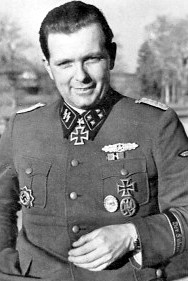
SS Sturmbannführer Helmut Kämpfe
Meanwhile, troops of the 1st Battalion of the “Der Führer” Regiment marching from Tulle via Limoges arrived at Saint Junien around midday having undergone numerous resistance attacks and road blocks along the way . The commander of this Battalion, was SS-Sturmbannführer Adolph Diekman. A meeting subsequently took place at the Hotel de la Gare (Station Hotel) at Saint Junien, between the SS officers, Milice (French Fascist Police) and the NAZI security police from Limoges.
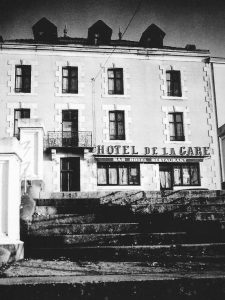
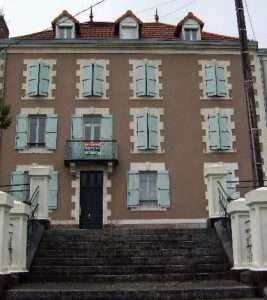
Hotel de la Gare, Saint Junien in 1944 and as it is today
It had been decided that “an example must be made” although the severity of what this meant is not clear and accounts vary as to why the choice was Oradour sur Glane. Some suggest Saint Junien was considered, but was too large. Other accounts say that Oradour sur Glane was mistaken for the village of Oradour sur Vayres where they thought Kämpfe may be imprisoned or where resistance units were based. Diekmann said the decision had already been taken at “Regimental level” back in Limoges.
A Company detachment under 36 year old SS Captain Otto Kahn was ordered to undertake the mission. Being a combat Waffen SS unit, in addition to German soldiers, Kahn’s troops were a mix of nationalities from occupied countries, probably pressed into service under duress and including, Russians, Poles, Croatians and even 20 French from the occupied region of Alsace.
At 13:30pm, with Diekmann at its head, Kahn’s company set off on the 8 miles (13km) journey to the pretty little village of Oradour nestling beside the picturesque tree lined River Glane, with its houses, café’s, shops, post office, blacksmith, garage, workshops, schools and farms, plus a tramway and 12th century church.

Oradour sur Glane – c.1930
The village had grown during the war years with several refugees from Spain, the Occupied Zone and a number of Jewish families escaping persecution to this small haven in rural France. No one had recalled having seen any German troops in the village for almost 3 years and there was a feeling that they had been “missed” by the War, but around 2pm the ominous rumble of armoured half-track vehicles and troop transports could be heard as they began to surround the village.
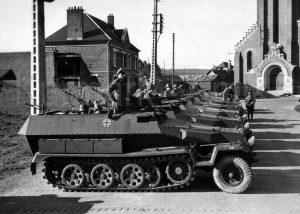
At 2:00pm on Saturday 10th June 1944 around 180 SS troops arrived at the village in 12 trucks preceded by armoured semi-tracked troop carriers like these Sd.Kfz 251’s.
Robert continued, “We went out to the back of the house and we climbed the garden wall. At that moment, we were shot at by machine-guns. We thought the SS had surrounded the wood where we were going to take refuge. So we climbed down the wall and we hid under some thick bramble bushes and stayed there, motionless and mute. We were about 200 metres from the house. Suddenly, a German appeared near the wall and he scanned the garden. He passed just two metres away from us, but did not see us and he turned around. Then we heard the infernal sound of numerous bursts of machine gun fire… Soon thick smoke appeared, which dropped all around us, making it hard to breathe.
With ruthless efficiency the villagers had been assembled in the main park, the “fair-ground” at the centre of the village, men on one side, women and children on the other. At around 3:30pm the 190 men were grouped into units and marched to six separate sites in the village (sheds, barns, garages); namely Milord, Bouchoule, Desourteaux, Laudy, Denis and Beaulieu, and the 247 women and 205 children were herded into the village church where a large box of explosives and Teller mines with trailing fuses was placed in the centre of the nave. The doors were then locked.
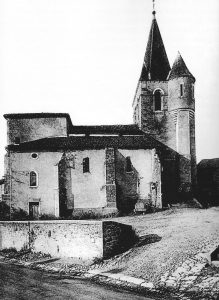 Saint Martins Church
Saint Martins Church
At exactly 4:00pm at the signal sound of an explosion the Germans machine gunned all the men packed in each of these separate locations and then set fire to them – alive or dead. They then set about hunting down any survivors.
Shortly afterwards the bomb was detonated in the church, packed with 452 terrified women, children and babies (one was just a week old). The explosion did not kill everyone, so the SS finished the job with grenades and gunfire through the windows.
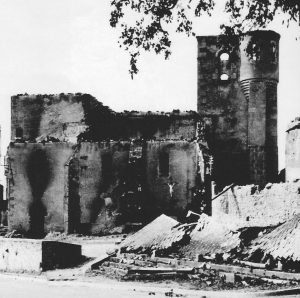
Saint Martins Church afterwards
Robert continues: During the following days, we were able to see for ourselves the extent of the terrible crime and the horror in Oradour. Without a doubt, my mother was burnt in the church, with the other women and children. As for my father, he was shot in the Beaulieu blacksmith’s shop. I know this because his scissors were found there (as drapers we always have scissors in our pockets), and his wedding ring, on which were engraved the date of his marriage, his initials, and my mother’s initials…”.
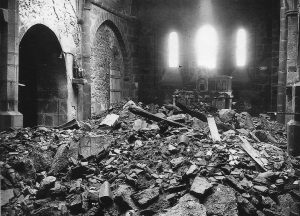
Interior of Saint Martin’s Church following the blasts
“My mother was burnt in the church with all the women and children. My father was machine-gunned and then burned in the Beaulieu Forge, where men were massacred. He was one of only 52 bodies of the entire village that could be identified for a death certificate to be established.
Having spent the remainder of the day looting and drinking, the SS set fire to the town except one house where those left on guard spent the night. They left the following day burning the remaining house as they left, but the SS returned a day later to dig two huge communal graves. Some days later German officers from the headquarters in Limoges arrived to investigate what had happened. Recoiling from the growing condemnation of the event, senior German officers, even including Field Marshal Rommel and those who has ordered the crackdowns, called for an enquiry into the “excessive unilateral action” of Diekmann, but a courts marshal enquiry was never undertaken as the War moved on and most of the principle protagonists were killed in action shortly afterwards.
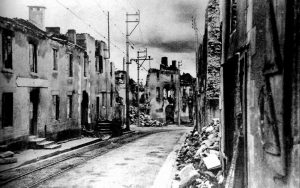
Robert’s father Guillaume was recognised with the French combatant title “Died for France” by the Rochechouart court on 10 July 1945. His name appears on the memorial to the martyrs of 10 June 1944 at Oradour-sur-Glane.
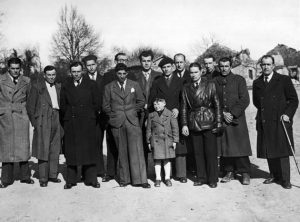
Survivors of the massacre. Robert is 4th from right.
Roger Gofrin – the little boy with red hair. Standing next to Robert in this picture is Roger Gofrin – just 7 years old. Along with his mother, Roger had been forcibly evicted from their home in the Lorraine/Moselle border region when the Germans invaded. They lived in Oradour along with other refugees from across France, and because of their experiences, his mother was often heard telling Roger, “if you see Germans – hide“. He was at one of Oradour’s primary schools on 10th June, and when the SS arrived he did just that, for no other reason than that was what his Mum had told him to do. He hid in the fields of tall grass nearby, then made a run for the river as fast his little legs could carry him. He was spotted and a German soldier shot at him but he escaped. He was one of only two children, and the only schoolchild, to survive, but his mother died in the church along with all his schoolmates. When he grew up he joined the Armée de l’Air as a cadet. Roger died in 2001.
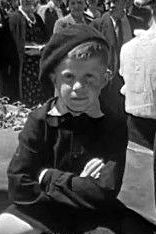
Roger Gofrin – aged 7¾
11 people had incredibly survived the actual shootings and others had hidden or escaped beforehand. A formal enquiry was held in Bordeaux on 12th January 1953 against the 65 known SS perpetrators.
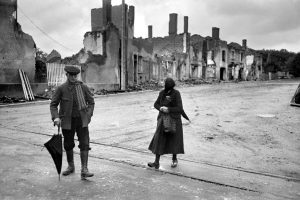
The village was never restored and stands today as it did on that fateful day in June 1944 – a moment in time captured forever as a memorial to those who died and as a record of the inhumanity, to remind the rest of us what war and human beings are capable of.
Oradour sur Glane is lovingly preserved and the Centre de la Memoire – Village Martyr Museum is visited by many thousands of people throughout the year. It is a place of deep emotion and reflection for everyone who visits as they imagine the horrors which took place around the blackened shells of these everyday homes and rusting domestic artefacts. https://www.oradour.org.
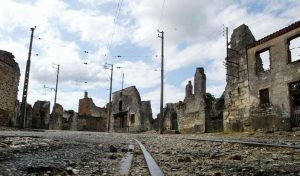
Oradour sur Glane today – the Besson Drapery Shop is straight ahead
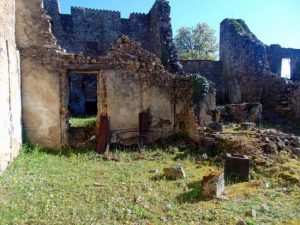
The rear of Robert’s family home
The Memorial Village of Oradour sur Glane – today.
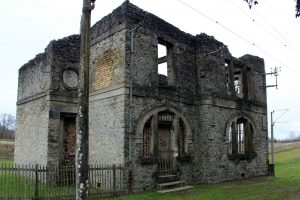
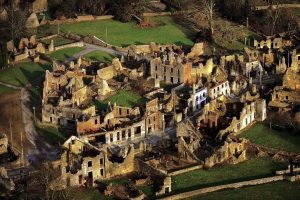

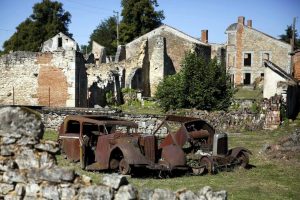
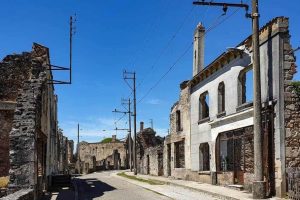

POSTSCRIPT
Robert’s brother Abel, returned from the War and married Anne Marie Dardilhac in Cieux.
Robert married Jeanne Marie Paule Quériaud on 24 January 1945 in Saint Junien church and they had three children (all girls). He was a formal witness at the war crimes trial at Bordeaux in 1953 and ran his retail clothing business in Saint Junien until he died in 2008 aged 91.

Robert and his new bride Marie – January 1945
Robert’s daughter Brigitte continued the family business at Saint Junien until 2018 and remains to this day one of my closest friends.
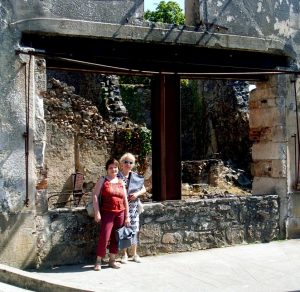
Caroline Broch (right) with Robert’s daughter Brigitte outside the remains of her grandparents shop at Oradour sur Glane. (2019)
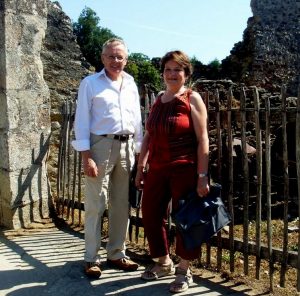
Brigitte (née Besson) with Ian Reed at Oradour 2019
“The Man with the White Handkerchief” – written & produced by Ian Reed from
the recollections of Caroline Broch: “Elvington Echoes – Poèmes de Guerre” –
https://afheritage.org/elvington-echoes-raf-bomber-command
© 2022 AFHG/GPFA

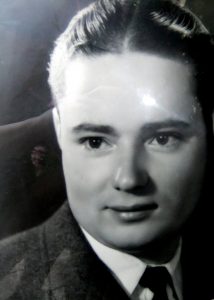
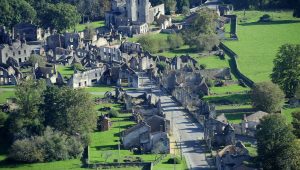
This has moved me more than anything that I have read for a very long time. Beautifully written and ending on a note of hope. Lest we forget.
I live about 2 hours drive from Oradour and have visited it. Total devastation with very little sound to distract your thoughts.
This and many other atrocities by the Germans here in France during both World Wars underline the right for those who suffered from their bestial behavior never to forgive nor forget.
I visited Oradour about 25 years ago before I eventually moved to live near Bergerac. There are memorials in the village where I live where Maquisards were executed by the SS at the same time in 1944 as Oradour suffered such a cruel devastation.
I live one and a half hour from Oradour sur Glane and have visited the memorial three times, the last time with my brother, who was so shocked, as I am by the Nazi military leaders ordering such reprisals. I’m so glad that the memorial remains to remind future generations of the horrors of war. The man with the white handkerchief is beautifully written and portrays the sadness of the few who escaped to tell the of the horror. To think that this happened during my brothers and my lifetime. We survived the London bombings, but that’s another story.
I lived for several years in Oradour-sur-Vayres, almost in the commune of St Laurent-sur-Gorre. My neighbour Henriette told me how they saw the smoke rising from Oradour-sur-Glane and learned a few days later about the terrible massacre. I have visited the site three times. I will not enter the ruined village again; the impact is too emotive. If I take a visitor there, I sit outside in my car, with my thoughts. When Acting-President De Gaulle visited Oradour-sur-Glane to declare the site a national memorial, my friend Francoise, then aged 6 or 7, was there with her family. ‘Oncle Charles’ had visited their home in Limoges; Colonel Bouton had served alongside De Gaulle throughout the war. In 2020 I wrote a piece for the English Language monthly, ETCETERA, about Denise Bardet, the young teacher who was murdered at Oradour on her 24th birthday, for 10 June 2020 would have been her 100th birthday. This young lady kept a journal, in which she respected German culture and wrote of the distinction between civilsed Germans and the NAZI thugs who were to kill her. Lest we forget.
Thank you Ian, for keeping the memory alive with this heartbreaking story.
Photos and words are very well chosen.
You succeeded to pass on all the emotion.
I visited Oradour with my wife 9 years ago my wife found it very emotional and upsetting.
Thank you Ian for keeping this memory alive with your beautiful, poignant words. If you hadn’t had the courage to ask we may never have known this story.
This is a shocking reminder of how the War was not won but lost by those thinking that the best form of defence is attack. To use violence to control your enemy, the population you’ve invaded, until it it “gives in to your demands” is no way to bring peace to a nation. How can people find forgiveness when such atrocities occur against them? I do not know, but somehow we must!!!
May we never forget that all sides contributed to atrocities, but in this case the Germans have shocked me to the core.
Tears for those who died; hope for those who managed to survive, and thus created future generations.
We must never forget, we must learn to forgive those who trespassed against us, and we must fight against going to war at all costs.
I found it very fascinating and hope to go there same time